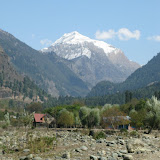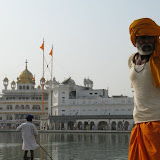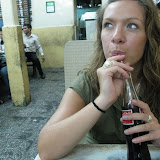We only had a few days in Delhi as were heading back to Rajasthan for the second part of the Pushkar Camel Festival which was already underway, so we decided to check out Old Delhi first. If you can conjure up the chaos of central London on a busy Saturday afternoon around Christmas time (not pleasant I know), then you are part way to conceiving just how busy Old Delhi is - chuck in load of cows and dogs, swap Hackney Carriages and red buses for black and yellow three wheeled Autos and bone shaking Victorian cycle rickshaws, and imagine nothing has been cleaned for a about a hundred years, and you start to get the picture. Old Delhi is miracle of the urban world; how it functions is not quite clear, but somehow it does - Chandi Chowk, the long crazily busy main road running from the junction at the Red Fort is a effectively Old Delhi's Oxford Street with a maze of side streets and Bazaars connected to it. Stopping to look at anything is a dangerous game, as even the mildest whiff of interest on your part is tantamount to you wanting to buy. Shopkeepers shout enthusiastically to grab your attention from all sides and for all sorts of products - quite why an Englishman abroad would suddenly need to buy a king size mattress, a load of Tupperware, some industrial detergent an old pram I wasn't sure, but these apparently were items I needed in my life. On reflection, the mattress could have come in handy with some the beds we've been sleeping on, and maybe I could have wheeled it round on the pram, but I'm still reasonably convinced declining to purchase was the right decision on this occasion.
Venturing into the Bazaars is a voyage into the unknown, and frankly we had no idea where they led to or where they came out, so we just wandered, pushed along by the human tide. Inside the tiny network of streets lies total chaos. Although not totally covered, a strange filtered half-light pervades due to the high sided buildings flanking the walkways and the loose wiring hanging down from the dense spiders web of cabling overhead. Small shops trading mostly jewelery or fabrics are packed tightly together with barely any room to move in between, and at points the bazaar came to a total standstill with no-one able to move. Invariably then someone on a motorbike loaded with boxes would appear and try to squeeze down the middle causing further chaos, but somehow it all keeps moving. You get the impression that bar the presence of modern technology, this is probably not far off how it all operated a century ago.
Eventually we emerged onto a main street, and spent the rest of the afternoon looking round the old city with the odd beer in between. Getting lost is not really a problem either as you're never more than ten yards from a rickshaw, so when we'd had enough we headed back to the relative calm of the hotel. That evening we decided to go posh and eat at one Delhi's more stylish restaurants on Connaught Place. We even had a bottle of wine - the first one in a month, which, as Sam pointed out, is probably a new record for me. We'd both heard mixed reports about Delhi but it's really likable place. Yes, it can be dirty and overcrowded and intense, but it has a lot of character and it's certainly unlike any other capital city you're likely to visit.
We spent a couple more days exploring before catching the six thirty AM Shatabdi Express to Pushkar for the Camel Festival. Pushkar is a small but striking Rajasthani desert town that once a year plays host to a huge Camel trading fair combined with a religious festival. We'd been told that the holy lake the town surrounds was "a bit low" this year and that it would likely have a negative effect on the numbers of pilgrims visiting, but this clearly wasn't the case - the town was heaving with a mix of hard looking desert traders, fair people, pilgrims, backpackers and the extraordinary looking Sadhus who'd made the journey. Clearly the festival was an an annual Indian photography highlight too, as I've never seen as many cameras in one place - some with telephoto lenses as long as your forearm. This was looking like fun and were both looking forward to a few days at the weirdest festival we'd been to yet. Unfortunately, things didn't pan out as expected and the following morning while working our way through a crowd leaving a temple, I got my bag stolen which contained my Canon camera, prescription glasses, sunnies, wallet, and all my bank cards - basically everything useful! The whole previous afternoons and evenings pictures were on the camera too and we were now left sans camera for what was probably the best opportunity to get some amazing images we'd have in Northern India...frustrating was not the word. Anyway, we're insured, so it was more a case of frustration than anything, but the police were utterly useless, being by run by a Rajasthani version of Chief Wigam. It was patently obvious that there was zero chance of getting anything back. After a bit of research into getting a new camera it also meant we'd now have to go back to Delhi (before heading onto Jaipur) to buy a new one, and we could also replace fairly easily there the rest of the things that had been stolen. As days go though, it wasn't a good one and I was not a happy traveler that afternoon. Plus, to add insult to injury, we'd missed the moustache competition, which after 3 weeks of growth I was bound to win.
By next morning we were feeling a bit more philosophical about the whole affair and we just decided to get on have a good time, so we headed off to explore the town. The lake being "a bit low" turned out to be a sizable understatement; there was basically no water at all in it except for a large brown puddle in one end, and the result was a huge dry dirt bowl. My suggestion to a shopkeeper we got chatting to that Pushkar should host a monster truck and dirt bike extravaganza in it and call it Flying Sadhus didn't go down well - I decided it was probably best not to try and explain who Evil Knievel was either. Anyhow, the lack of water didn't seem to deter pilgrims heading down en masse to bathe in the temporary man-made pools constructed at the side of it. I have frankly never seen swimming pools looking more rancid, but maybe being full of holy water maybe they were self-chlorinating. Either way, everyone seemed to be having a great time dunking their younger brothers and mother-in-laws all afternoon - it must be quite a sight with the lake full.
One of the other most most fascinating aspects of the festival were the huge numbers of Hindu Holy men; Sadhus and devotees who had made the journey. Mostly they spent the day sat in groups together around the lake with incense laden mini-shrines they had built either talking loudly or meditating silently. Without doubt they are some of the most otherworldly looking people you will ever encounter, and most of them smoked more than Bruce Willis in Die Hard. It became clear why the mammoth telephoto lenses were needed too - travelers attempting to taking close up holiday pictures of them meditating were given a good Hindi bollocking and the old boys could get fairly animated when confronted with a snap-happy tourist. Fair enough though - it can't be easy pondering lifes great questions in the face of an Australian brandishing a cameraphone shouting "give us a smile mate".
From Pushkar we headed back to Delhi again and spent a couple of days re-buying the stolen items. We checked out smart New Delhi and the shiniest shopping mall we'd seen outside of Europe, spent too much money in expensive restaurants, and had a few boozy nights in some seedy bars in the old town - one of which was strangely full of grown men in suits drinking whisky watching The Flintstones. Jaipur turned out to be a flying visit, partly due to having ingested something that took a disliking to us, and what we saw was interesting, but we both felt a little underwhelming. The comedy highlight however was being me getting charged by a moody street cow in the town centre and trying to fend it off with a plastic water bottle which exploded on impact with its head - unleashing the contents all over my T-shirt and face and causing much hilarity to the onlooking locals. A You've Been Framed moment if ever there was one.
Our final stop in Northern India was Agra, for the mighty Taj Mahal. Little needs to be said about this really, as clearly being one of the wonders of the modern world its beauty has been described a million times, but suffice to say it's an awe inspiring sight, a mind blowing piece of architecture and worth every penny of the visit. Finishing with the Taj was a magical end to our tour of the North West and after seven weeks of fairly intensive travelling, we were both pretty excited about reaching the lazy tropical south...
View our pics here
 |
| Delhi |
 |
| Pushkar, Jaipur & Agra |





